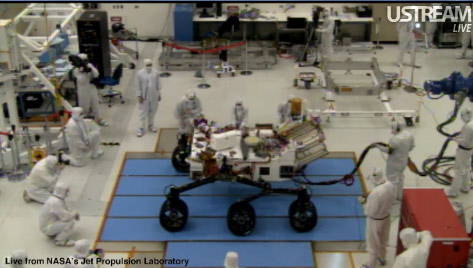New Mars Rover Takes First Drive ... On Earth

NASA'snext-generation Mars rover took its first baby steps on Earth Friday ? a fewshort drives that herald its upcoming mission to the red planet.
"Thisis great, this is really exciting," said Ashwin Vasavada, deputy projectscientist for the Mars Science Laboratory rover's mission. "This is a hugemilestone?It's a rover."
Theambitious new rover, named Curiosity, took center stage in the clean room ofNASA's Jet Propulsion Laboratory, showcasing a whole slew of new instruments and support features. It drove just about 3 feet (1meter) back and forth in its first drives.
NASAbroadcast the rover's first drives live in an Internet webcast.
Thisweek alone, spacecraft technicians and engineers attached the Curiosity rover'sneck and head (called the Remote Sensing Mast) to its body, and mounted twonavigation cameras (Navcams), two mast cameras (Mastcam) and the laser-totingchemistry camera (ChemCam).
Curiositywas also sporting a new set of six aluminum wheels, each about 20 inches (about half a meter) in diameter, as it took itsfirst drive on Earth. The large rover now stands at about 7 feet (2 meters)tall.
Therover will also be outfitted with a 6-foot (1.8-meter) robotic arm that carriesa large jackhammer drill and microscope. The rover will be able to drillapproximately 2 inches (5 cm) into rocks, and sample the composition of thepowder.
Get the Space.com Newsletter
Breaking space news, the latest updates on rocket launches, skywatching events and more!
Therover is scheduled to launch in 2011 and touch down on Mars soil in August 2012. MSL's primary mission is to study thehabitability of a landing site on Mars, and to conduct tests on Martian rocksin order to sample the planet's geological history.
"We'vebeen following the water for a decade of so, and now we know there is water onMars," he said. "What MSL will do is take a next-generation set ofinstruments, and in detail, determine the habitability."
And,everything appears to be progressing nicely.
"It'salways wonderful to see a baby take its first steps," said Kevin Talley,who was a driver for the twin Mars Exploration Rovers Spirit and Opportunity. "Andthat's a big baby."
TheSpirit and Opportunity rovers landed on Mars in January 2004 for whatscientists initially planned to be a 90-day mission, but both have faroutlasted their life expectancies.. Now, more than six years later, Opportunityis still going strong as it rolls toward a huge crater called Endeavour.
Spirit,meanwhile, has transitioned into a stationary explorer on Mars, after gettinginescapably stuck in deep Martian sand last year. It is currently in ahibernation state due to low sunlight levels for its solar arrays, missionmanagers have said.
- Gallery ? Latest Mars Photos From Spirit and Opportunity
- The Best and Worst Martian Landings
- Video: Building Curiosity ? Mars Science Lab Unveiled
Join our Space Forums to keep talking space on the latest missions, night sky and more! And if you have a news tip, correction or comment, let us know at: community@space.com.

Denise Chow is a former Space.com staff writer who then worked as assistant managing editor at Live Science before moving to NBC News as a science reporter, where she focuses on general science and climate change. She spent two years with Space.com, writing about rocket launches and covering NASA's final three space shuttle missions, before joining the Live Science team in 2013. A Canadian transplant, Denise has a bachelor's degree from the University of Toronto, and a master's degree in journalism from New York University. At NBC News, Denise covers general science and climate change.









